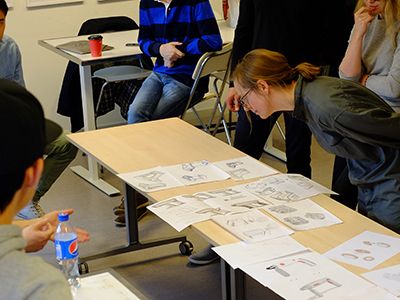The course includes five seminars where some theory and many sketching techniques are taught and practiced. At the final presentations the focus lies on discussing what the sketches express, and their usefulness in different contexts. Most of the course work lies in producing five individual hand-ins between the seminars.
MF2097 Advanced Sketch Exercises 3.0 credits

Through seminars, coaching and practice the students get support to develop the ability to illustrate design concepts with sketches. The techniques and principles are useful for many purposes, from idea generation and concept development, to more developed visualizations for presentations.
Information per course offering
Choose semester and course offering to see current information and more about the course, such as course syllabus, study period, and application information.
Information for Spring 2026 Start 16 Mar 2026 programme students
- Course location
KTH Campus
- Duration
- 16 Mar 2026 - 1 Jun 2026
- Periods
- P4 (3.0 hp)
- Pace of study
17%
- Application code
60544
- Form of study
Normal Daytime
- Language of instruction
English
- Course memo
- Course memo is not published
- Number of places
10 - 30
- Target group
Optional only for TIPDM, track IPDC
- Planned modular schedule
- No information inserted
- Schedule
- Schedule is not published
- Part of programme
- No information inserted
Contact
Course syllabus as PDF
Please note: all information from the Course syllabus is available on this page in an accessible format.
Course syllabus MF2097 (Spring 2020–)Content and learning outcomes
Course disposition
Course contents
Intended learning outcomes
After passing the course, the students should be able to:
- visualise form and design concepts by means of freehand sketches.
- reflect on how different levels of sketches and visualisation influence discussions in a development project.
- use different techniques for freehand sketches and describe their advantages and disadvantages.
- describe how digital techniques can be used for sketching and visualisation.
Literature and preparations
Specific prerequisites
Course require basic sketching skills from courses
MF1061 Introduction to Design and product realisation
MF1062 Design and product realisation, or the equivalent.
Recommended prerequisites
The course requires sketching knowledge and experience that is the equivalent of having passed the two introductory design courses at the Design and Product Development bachelor program at MMK. Here, a total of eight short sketching seminars are included, and hand-sketching is also required in the course projects.
You need to have a basic understanding of 1- and 2-point perspective drawing, and some experience of hand sketching to ideate and develop concepts. The course focus lies on sketching techniques used in the field of product design (industrial design). This means that the focus is on speed, and on developing product form/gestalt, but arts-classes or architecture studies could likely provide the requisite knowledge.
Literature
Examination and completion
If the course is discontinued, students may request to be examined during the following two academic years.
Grading scale
Examination
- ÖVN1 - Exercises, 3.0 credits, grading scale: P, F
Based on recommendation from KTH’s coordinator for disabilities, the examiner will decide how to adapt an examination for students with documented disability.
The examiner may apply another examination format when re-examining individual students.
The student should complete and submit all exercises with documentation, at a level reasonable for the scope of the course.
Active participation in seminars, exercises and presentations.
Examiner
Ethical approach
- All members of a group are responsible for the group's work.
- In any assessment, every student shall honestly disclose any help received and sources used.
- In an oral assessment, every student shall be able to present and answer questions about the entire assignment and solution.